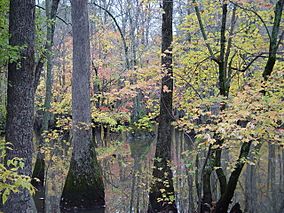Cache River National Wildlife Refuge facts for kids
Quick facts for kids Cache River National Wildlife Refuge |
|
|---|---|
|
IUCN Category IV (Habitat/Species Management Area)
|
|
 |
|
| Location | Arkansas, United States |
| Area | 68,993 acres (279.20 km2) |
| Established | 1986 |
| Governing body | U.S. Fish and Wildlife Service |
| Website | Cache River NWR |
| Official name: Cache-Lower White Rivers | |
| Designated: | 21 November 1989 |
| Reference #: | 442 |
The Cache River National Wildlife Refuge is a special protected area in Arkansas, USA. It covers about 69,000 acres, which is like 52,000 football fields! This refuge is managed by the United States Fish and Wildlife Service. It's recognized worldwide as an important wetland under the Ramsar Convention.
This refuge is super important for many reasons. It's a key winter home for ducks. It also has the biggest remaining area of bottomland hardwood forest in North America. This type of forest grows in low, wet areas. In 2005, people thought they might have seen an ivory-billed woodpecker here. This bird was believed to be extinct, making the refuge even more famous! The refuge plans to grow even larger in the future.
Contents
Saving the Cache River
In the 1970s, duck hunters helped save the Cache River. They stopped the U.S. Army Corps of Engineers from digging up and straightening the river. This effort led to the refuge being created in 1986.
The nearby town of Stuttgart, Arkansas is known as the "Rice and Duck Capital of the World." The refuge follows the Cache River's flood-plain for about 70 miles. It stretches through several counties in Arkansas.
What the Refuge Protects
The Cache River National Wildlife Refuge has grown over time. It buys land from private owners who want to sell. Much of this land used to be farms. The goal is to plant native trees and plants again. This helps restore the natural environment. The refuge protects the largest area of bottomland hardwood forest left in the United States.
The refuge has about 47,000 acres of this special forest and wet areas called sloughs. It also has many oxbow lakes. These are U-shaped lakes formed when a river changes its path. About 17,000 acres of former farmland are now being replanted.
Amazing Animals
The refuge is home to over 50 types of mammals. You might see deer, raccoons, bobcats, and river otters. Nearly 240 kinds of birds live here too. This includes many ducks, geese, and other migratory birds. The wet forests also host 48 types of reptiles and amphibians.
The Cache River refuge is the most important winter spot for mallard ducks in North America. It's also home to the only native black bear population in Arkansas. Other wildlife refuges are nearby, like Bald Knob and White River National Wildlife Refuges.
The Mystery of the Ivory-billed Woodpecker
On April 29, 2005, a team from Cornell University said they saw an ivory-billed woodpecker in the refuge. They even had a short video and audio recordings. This bird was thought to be extinct for 60 years!
After this exciting news, much of the refuge was closed to the public. Scientists wanted to search for the woodpeckers. However, they couldn't find more evidence of the birds. So, the refuge was reopened in 2006. Whether the bird was truly seen in 2005 is still a big debate!
Fun Things to Do
About 120,000 people visit the refuge each year. It's a great place for outdoor activities! You can go hunting for deer, ducks, and geese during certain seasons. Fishing is allowed all year round.
Many people enjoy canoeing on the rivers and lakes. It's also a fantastic spot for watching wildlife and taking pictures. You can see many different animals and beautiful scenery.
Future Plans
In 2012, the U.S. Fish and Wildlife Service suggested a big plan. They want to expand the Cache River Refuge much more. The goal is to buy land from willing sellers. This would help restore more natural ecosystems. It would also replant cleared land. This expansion would connect different parts of the refuge. It would create a larger, healthier home for wildlife.
The expansion aims to reconnect the Cache River and Bayou DeView watersheds. This would allow more land to be reforested. It would also extend the refuge northward along Bayou DeView. Another goal is to connect the refuge with other protected lands along the White River.
Because many landowners are involved, buying all this land will take many years. But it will help protect this special place for future generations.



